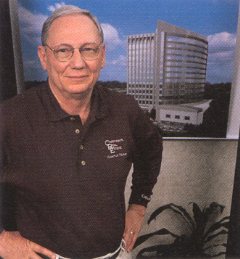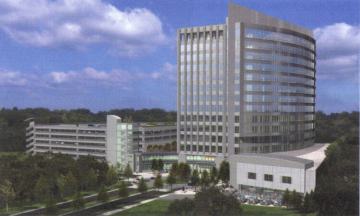W |
hen the average age of a company’s employees is just 31, it’s a safe bet that its parking lots are full of Jeeps and the interior workspace is downright hip. While popular taste in cars may change from year to year, at least one such company’s commitment to maximizing the value corporate real estate assets is carved in stone.
Capital One, the Virginia-based consumer credit giant, is a riveting business story on many levels, from its management of meteoric growth to its highly effective product-development strategy. But the most important story unfolding in the bank’s myriad locations is the role corporate real estate plays in implementing corporate culture and helping executive management achieve strategic and financial objectives.
But some pretty compelling circumstances are now putting the corporate real estate team’s acumen to the test. In October 2000, Capital One announced the largest corporate expansion plan in Virginia’s history: the development of three distinct campuses in the greater Richmond area — one of which is a major new campus location and two of which represent consolidations of existing property assets. In May 2000, the bank announced plans to create a 30-acre (12-ha.) global headquarters complex in Tyson’s Corner, Va., not far from its current base in Falls Church, Va.; both are suburbs of Washington, D.C.
The scope of these projects is immense — certainly impressive enough to earn a place in Site Selection’s Top Deals of 2000 and a Site Selection Corporate Real Estate Leadership Award for Capital One’s Bill Yontz, vice president, corporate real estate. Consider the numbers. The combined projects will result in the hiring of more than 8,200 new employees through 2004. The three Richmond area campuses will require a capital investment of US$700 million. The bank’s contribution to Virginia’s gross economy already exceeds $1.3 billion annually, according to an estimate from RKG Associates (www.rkg1.com), an economic development consulting firm with offices in Alexandria, Va., and Durham, N.H. And the ultimate benefit of Capital One’s expansion plans to the state’s economy will be $2.4 billion annually. To put those numbers in context, the state of Virginia in 2000 announced capital investments of about $6.5 billion for the year.

“This expansion represents a new chapter in Capital One’s history from two standpoints,” says Yontz. “For the first time in our growth history, we are undertaking consolidations while we are growing, whereas in the past we have added to the real estate portfolio to accommodate growth. And this is the first time we will have designed the workplace around the professional staff,” adds Yontz. “We are creating a workplace that is geared to the culture of the company.”
This has largely been achieved already in the call center and operations facilities, where signs of fresh workspace thinking abound. Capital One takes Yontz’s point about blending the corporate culture with the workspace quite seriously. “All of senior management is very engaged in this process,” he asserts, “from the workstations to the office strategy to the collaborative space and conferencing strategy to amenities — all of these workspaces are being designed through the prism of our culture.”
ABOVE: Bill Yontz, Capital One’s vice president of real estate.
Adds Joel Ratekin, director of workplace strategies, “The campuses are windows of opportunity where we will able to touch a large percentage of our professional staff at one time. Working with the communications group, we will be able to implement change management programs that help support the culture in a more effective way than we can do now. It’s an opportunity to look at wireless environments, digital streaming and other new technologies and open environments that nurture the collaborative aspect of what we do.” Testing of new workspace concepts is ongoing at Capital One.
“Our eight-member campus governance committee [of which Yontz is a member] is a very powerful vehicle for us to implement a strategy and vision for the workplace,” says Eric Thorpe, director, corporate real estate. “The real significance of the group to me is that we have a group of senior executives who not only care about the workplace but are also very knowledgeable. This means we have advocates at the most senior level of the company concerned with the work place.”
It’s much harder to infuse corporate real estate with that culture when it is as dispersed as Capital One’s is. The bank leases space in 27 buildings in Henrico County alone. “When you’re in hyper-growth situations, as we have been in Richmond, you’re basically relegated to leasing every bit of real estate that comes out of the ground,” says Yontz. “The campuses are a way to get ahead of that. Otherwise, we’re not doing our own planning — we’re at the mercy of the market.”
What’s on the Way
 Capital One’s largest project of the three announced in October 2000 is the new, 318-acre (129-ha.) West Creek Campus, in Goochland County, a few miles from Richmond’s Innsbrook area where the bank leases space in 19 buildings. The campus will consist of 1.5 million sq. ft. (139,000 sq. m.) of space in eight buildings initially with capacity for 2.2 million sq. ft. (204,400 sq. m.) in 13 buildings. Occupancy is scheduled for early 2002. On a very practical level, productivity will necessarily increase, says Yontz, relative to the current situation. “It’s not uncommon for people to have to go to six or seven buildings in a day,” he relates. “Driving around all day and parking and so forth chews up a lot of time.”
Capital One’s largest project of the three announced in October 2000 is the new, 318-acre (129-ha.) West Creek Campus, in Goochland County, a few miles from Richmond’s Innsbrook area where the bank leases space in 19 buildings. The campus will consist of 1.5 million sq. ft. (139,000 sq. m.) of space in eight buildings initially with capacity for 2.2 million sq. ft. (204,400 sq. m.) in 13 buildings. Occupancy is scheduled for early 2002. On a very practical level, productivity will necessarily increase, says Yontz, relative to the current situation. “It’s not uncommon for people to have to go to six or seven buildings in a day,” he relates. “Driving around all day and parking and so forth chews up a lot of time.”
ABOVE: The bank’s West Creek Campus, near Richmond, Va., is the most ambitious of the
three development projects underway. It has a capacity of 2.2 million sq. ft. (204,400 sq. m.).
Yontz and his team are considering several options with respect to the Innsbrook properties; Capital One currently occupies 2.4 million sq. ft. (223,000 sq. m.) of space in the area. The goal is to reduce the number of facilities in which the bank occupies space from 19 to a handful of strategically located properties that would serve as an operations campus, complete with corporate amenities and design features consistent with those at other locations. A 122,500-sq.-ft. (11,400-sq.-m.) building already stands at Capital One’s third Richmond-area campus, known as James River Center. Construction began on a second building at that location in October 2000; occupancy was to commence in mid-2001.

The northern Virginia campus, situated at the intersection of I-495 — the Beltway — and Rte. 123, will feature a 14-storey office building for 1,700 workers. The master plan allows for three more buildings at the site capable of providing space for 4,000 more employees.
And in the United Kingdom, work is well under way in the development of a new corporate campus in Nottingham, which will support operations in Great Britain and the rest of Europe. Trent House is a 250,000-sq.-ft. (23,200-sq.-m.) building that houses a call center, operations and other corporate functions. About 2,000 people work in the refurbished former factory.
ABOVE LEFT: Capital One’s new headquarters campus, currently under construction,
is located at the intersection of Rte. 123 and Washington, D.C.’s Beltway, in Tyson’s Corner, Va.
“That turned out to be a very successful project in that we worked very closely with our IT people and managed to integrate all the facilities together in one go,” says Gary McMahon, senior project manager, corporate real estate in the U.K. “IT is quite separate from the real estate team in some organizations, but we had the opportunity to pull them together on this project, and that’s worked out very well — in terms of the new project, as well.”
McMahon is referring to SiteOne, a new building under construction adjacent to Trent House in central Nottingham. Among other innovations, SiteOne is designed in such as a way as to deliver more floor-to-ceiling space than a typical building of its size normally would — and it saved $300,000 in construction costs, as well. “We’re looking at other areas around Trent House, as well, because we have a vision of developing a campus in that area.”
The Company State
As for why Virginia won the U.S. expansion project — Capital One also operates facilities in Tampa, Dallas, Seattle Boston and Boise, Idaho — it had an edge all along, Yontz allows. The bank employs more than 10,000 people in Virginia alone. When fully built out, Capital One will be the largest non-manufacturing employer in Virginia. “Most of our professional staff is in Virginia, and these campuses really support the professional staff, so there wasn’t much question about where they would go,” he says. “We did look at different options, but given the way we work as a company, it is important to have the various professional staffs together. We get a lot of synergy that way.”
Siting non-professional staff facilities, such as those in the other U.S. locations, is based mainly on labor market analysis, says Yontz. “We don’t even think about real estate when we select those sites. We are more disciplined than anywhere I’ve ever been and probably more so than most companies in that sense. We will not let real estate drive the labor market decisions. We don’t worry whether there are buildings there or not, because these are long-term decisions. If there is no commercial real estate in the location we choose, then we’ll put it there.”
Figuring out how much space will be required and where to locate it from a labor availability perspective is no small feat when numbers of employees involved reach so far into the thousands. Which is where Catherine Cotman’s team comes in. Cotman manages the banks integrated capacity-planning group. “We develop total company headcount demand forecasts looking mainly three years out,” she explains. Staffers working with the business units ascertain and anticipate business drivers and changes that will impact long-term headcount needs. The group also does scenario modeling to help forecast growth.
“On the supply side, we develop city strategies, making recommendations to senior management about when and where we should be opening offices in new cities, or where to grow in terms of our existing portfolio,” says Cotman. “The four legs to the capacity stool on the supply side are seat supply, hiring capacity, IT and financial resources,” she says. Proprietary forecast models help Cotman’s team determine what the bank’s maximum sustainable size is in any given market.
“If we have an understanding of what the total population is in a given metropolitan area that might apply to Capital One, and if we have some understanding of demographic trends in that market, as well as some other factors, then we can estimate pretty closely what percentage of the population is likely to apply to Capital One over time,” Cotman relates. “From there, we can determine what percentage of those who apply are likely to make through our employee selection process and become part of the employee base. Then we can figure out long term, depending on how quickly we hire people, are we going to deplete the labor reservoir to a point where we can’t hire enough people? That becomes our long-term maximum sustainable size around which we can plan our long term real estate strategy.”
In the context of locating — or consolidating — so many facilities in the Richmond area, not losing employees was also critical to the site selection analysis, says Ryan Lorey, corporate real estate manager of transactions. “We were very concerned about not losing people,” he says. “We did a zip code analysis of all our employees in Richmond to determine where would be optimum areas in which to late so that when it came time to narrowing down sites, we weren’t risking the prospect of costing us employees.”
How Virginia Helped Close the Deal
Incentives factor into analysis of site choices, as well, “but here in the U.S. that doesn’t drive decisions,” says Yontz. “We would not make a decision purely on that basis, but it is a factor, and we’re pretty competitive. The quality, supply and dependability of the labor are the overriding factors.”
Nevertheless, “Virginia has worked diligently to assist Capital One in expanding their presence in Virginia,” says Barry DuVal, the commonwealth’s secretary of commerce and trade. “We want to continue to be the place of choice for expansions that can be made anyplace in the world.” With respect to the October 2000 new campus announcement, Gov. Gilmore approved several incentives, including $3 million from the Governor’s Opportunity Fund, monies from which flow to the towns or counties needing to improve infrastructure to support the expansion.
Capital One also has been authorized to receive $4 million from the Dept. of Business Assistance Workforce Services Program, which covers worker training and related costs. Another incentive at work in the expansion, a $20 million Virginia Investment Partnership Grant, rewards companies resident in the state for a minimum of five years, and discourages those companies from expanding in a neighboring state. “This particular grant was a key factor in attracting the major corporate campus,” says DuVal. Funds don’t flow to the bank until the sixth through the tenth year, by which point the return on investment will have been made, DuVal notes. “It’s the principle of paying for performance.”
The Greater Richmond Partnership is playing a key role in organizing and delivering various education and training services. “We are able to help Capital One as they recruit people into the marketplace,” says Gregory Wingfield, president of the partnership. The bank knows it will need to draw on the labor supply for years to come, he adds. “Part of our Gateway program with the chamber of commerce is to work with the educational community, kindergarten through grade 12 as well as the higher education community, to help them build a curriculum that will deliver individuals with the important communication and other skills they require.”
Information Is King
Data gathering and analysis are central to Capital One’s business strategy; the company uses an elaborate testing model known as IBS, or information-based strategy, to prepare and tailor new products and services for market. No less attention to data is paid to corporate real estate, where cost management techniques involve analysis of energy use, lighting requirements and productivity factors among other tests.
Employees are surveyed twice a year to gain insights into how they feel about their workspace, for instance. The real estate team tracks their responses over time to questions about lighting, functionality, privacy, cleanliness, conveniences, food services, break facilities, recreation and meeting space, all of which is tracked by building. Working on the issues that emerge from the responses enhances the real estate department’s ability to prioritize, plan and design future space requirements. But more importantly, it helps the bank retain employees, which is just one example of how closely Yontz’s group works with human resources and other key business units. Indeed, Yontz reports to the head of human resources, who by virtue of the importance of labor to the organization is a senior member of management.
Much has been made in recent years of the importance of integrating corporate real estate with other key business units, particularly human resources and information technology. While most corporate real estate teams aren’t sure where or how to begin such an effort, Capital One has it down pat. Within the corporate real estate group are teams dedicated to communications, which works on projects analogous to those a human resources team might handle elsewhere, and technology integration, among others.
For instance, Jim Hall, director of systems and technology, manages two IT groups within Bill Yontz’s purview. CREST, an acronym for corporate real estate systems & technology, which is a typical IT department dedicated to the real estate function. Workplace Technology Integration is a year-old team that among other tasks ensures that consistent IT practices are applied to the development and maintenance of new facilities. “This groups exists to put in place the information systems necessary for running a corporate real estate department,” says Hall. “We are currently putting in an integrated architecture with which to manage the portfolio, leases and building operations. We’re giving Bill the information he needs, which means having systems in place to capture the necessary information and get it into a format that’s designed for senior management.”
Bill Yontz and his colleagues will need lots of good information from a lot of people as the new facilities take shape. Capital One’s presence in the Richmond and northern Virginia areas is more than significant, and what’s in development now will improve on that. The Commonwealth of Virginia and thousands of workers are counting on it.

